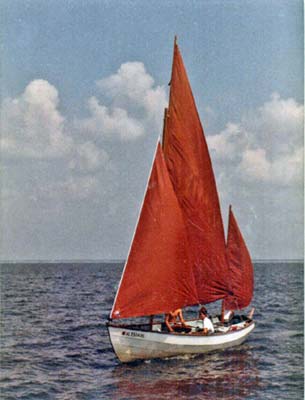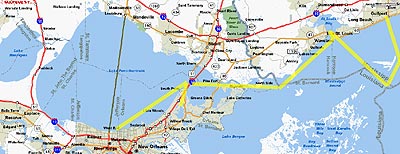|
The Drascombe in Mississippi |

|
|
By Frank San Miguel - Landenberg, Pennsylvania - USA |
In the summer of 1983, my friend Mark and I decided to take The Drascombe, my dad’s 21’ Drascombe Longboat, for a cruise. This was our third year in college and the weight of final exams had just been lifted from our shoulders – we were ready for some adventure. Our itinerary was to sail from New Orleans to Gulfport, MS, with a few stops in between (a total of about 80 miles - see map below).

After pulling an all-nighter getting the boat ready for the trip, we launched at dawn from the boat ramp near the Ponchartrain Causeway (a 24 mile bridge across the lake). At the last minute, we picked up another crewmember whose name I forget. There was no wind that day, so we motored the entire way to a friend’s house in the marshes east of New Orleans. Our third man turned out to be pretty poor company, but I was happy to discover he was also prone to seasickness. We dropped him off in at the house and, after a short afternoon visit, headed out to make some miles in the darkness. We motored and sailed for the rest of the evening and reached the Chef Menteur bridge (US hwy 90) around midnight. The bridge towered above us in the darkness, lit by a coupe of small navigation lights. I gave a toot on the horn and in an instant, huge floodlights turned our night into day. We though it was very cool and waved emphatically at the bridge keeper as we passed into The Rigolets (pronounced rig-o-lees in Louisiana).
We were tired, so we decided to anchor and get some rest. While motoring into a small bay just before the entrance to Lake Borgne, the boat was stopped cold with a loud “ping” and a jerk of the tiller. After a moment, we gained headway again, but this time the tiller was stuck. I steered with the motor until we were able to anchor. We speculated that we had hit a submerged pipeline and decided to wait until morning to attempt any repairs.
The Rigolets is the pass that connects Lake Ponchartrain and Lake Borgne with the Gulf of Mexico. The surrounding shores are typical southern marshland. Some people find this type of landscape monotonous and ugly, but I think it is full of natural beauty and diversity. It is also full of mosquitoes. We tried to zip into sleeping bags to avoid the bugs, but it was pretty useless. After fifteen minutes or so, we decided to try to setup the tent. We were attacked savagely as we pulled up the floorboards and laid them across the rowing thwarts. It made a flat platform in which to setup my Eureka 4-man triangle tent. The setup worked like a charm and we actually slept very well, while the bugs hummed lullabies outside (I have since used this technique many times, though it doesn’t work when there is much wind).
In the morning we dove under the boat to check out the damage. Our rudder was the one-part galvanized weldment type that draws about 2 ½ feet in its unbent form (I have recently gotten a kickup rudder for the boat which is much better for this type of sailing). The 1” diameter steel rudder shaft was bent 20 degrees from vertical and jammed into the rudder trunk. I unfastened the tiller from the shaft while Mark held the rudder underwater and dropped it down through the trunk. We motored to a small shipyard that was conveniently just across the channel on the north side of the pass. A ship welder cheerfully helped us out by placing the rudder into a huge vise and whacking on it with a big sledgehammer. After 10 or 20 blows, it was good as new.
That day we had a gorgeous sail, reaching with a steady 15 knot breeze at our quarter the entire day. Some porpoises joined us for about 30 min, staring at us with those big eyes and swimming back and forth under the boat. We sailed about 30 miles and passed into Bay St. Louis at dusk. We had arranged to stay at the Bay Waveland Yacht club at a guest slip, so once the check in was done, we swam and played around the beach and turned in early, this time sleeping in the boat under the stars.

Click image above for larger view
Dawn came with strong winds and heavier weather forecasted for later in the day. We sailed straight for Cat Island, a barrier island about 15 miles south of the mainland. By the time we reached the island, we had one reef tied in were making hull speed, with a southwest wind on our beam. As we sailed around the southern tip of the island (500 miles of Gulf of Mexico on our starboard) I showed mark how to ooch, a trick I learned from dingy racing. After a few tries we perfected the technique - scaled up for the Drascombe. While I manned the tiller, he ran from the stern and lunged at the mast, just as I headed up just a touch. We had to time it to coincide with the following waves, but the jerk from his sudden stop, the weight shift forward and the nudge to windward was almost always enough to get us up on a plane. Once up, we could usually surf a wave for a minute or more. We amused ourselves in this way for an hour or so until we almost buried the nose in the wave ahead of us.
By that time we had six to eight foot seas, a double reefed main and the jib rolled in quite a bit. We were still pretty comfortable, but I soon realized that my navigation was pretty bad. On the crest of one wave, I looked down into the water and noticed sand bottom just below the keel. I scrambled to the chart and discovered that we were sailing right over a clearly marked sand bar that stretched about a mile into the Gulf. Though The Drascombe only draws 9”, another episode with the rudder out there in the open sea would have been disastrous. There followed a few tense minutes where we heeled her as much as possible and then we were over it. Our enthusiasm was somewhat dampened as we rounded the eastern tip of the island and headed back to the mainland, but not enough to keep us from enjoying an exhilarating 15 mile reach. A small boat warning flag was flying as we glided into Gulfport.
This was long before the advent of Mississippi Gulf Coast casino gambling and Gulfport was still a small town whose chief industry was serving as a port of entry for banana boats arriving from Central America. We tied the boat at the municipal marina, met my family at our local vacation rental and slept very soundly.
We spent the remainder of the trip sailing in the Mississippi Sound and visiting Ship Island, which houses Fort Massachusetts, a Civil War era fort that has the distinction of having served as a prison to Geronimo.
It was a great trip and also my first cruise on The Drascombe. Just a precursor to many adventures to come.

Articles by Frank San Miguel:
|